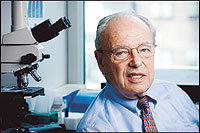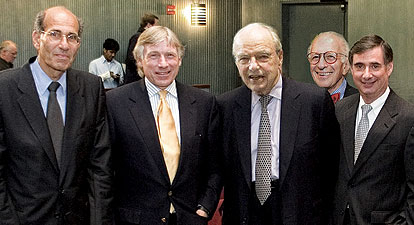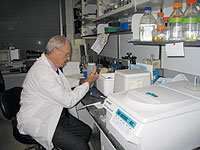|
|
 |
 |
|
FEATURESFighting the Cancer WarDr. Paul A. Marks ’46 and colleagues discover an anti-cancer treatment By Jeneen Interlandi ’06J, ’06 GSAS

Dr. Paul A. Marks ’46 is still actively engaged in researching SAHA, a groundbreaking anti-cancer drug. Photo: Abigail Heyman  In early September, more than 800 people — including eight Nobel Laureates, a host of university presidents and hundreds of notable scientists from across the country — gathered at Columbia University Medical Center’s Alumni Auditorium to honor Dr. Paul A. Marks ’46, ’49 P&S, president emeritus of Memorial Sloan-Kettering Cancer Center (MSKCC). There was much to celebrate. SAHA, the fruit of a 30-year collaboration between Marks and his Columbia colleagues, including University Professor Ronald Breslow, the S.L. Mitchill Professor of Chemistry, would soon be approved as the first drug of its kind to treat cancer. In some ways, SAHA is emblematic of all that Marks has achieved at MSKCC. He took its reins in 1980, charged with updating the institution’s lagging research program. Marks’ approach to the task included a series of controversial administrative decisions designed to shift the research focus from immunology to the emerging field of molecular biology. Less than a decade into his tenure, a lengthy New York Times profile of Marks painted him as a tough, forward-looking leader. Twenty years later, those tough choices have paid off. The cancer center now is at the forefront of biomedical research, and SAHA promises to usher in a new era of molecular-based cancer drugs with lower toxicity than any chemotherapy in use today. As Dr. Lee Goldman, Columbia’s e.v.p. for health and biomedical sciences, pronounced at the symposium, “Paul is the epitome of the physician-scientist.” 

Scientists and dignitaries gathered in September at the Columbia University Medical Center’s Alumni Auditorium to honor Marks. Among the attendees were (left to right) Nobel Laureate and University Professor Dr. Richard Axel ’67, President Lee C. Bollinger, Marks, Nobel Laureate and University Professor Eric R. Kandel and E.V.P. for Health and Biomedical Sciences Dr. Lee Goldman. PHOTO: CHARLES MANLEY  At 80, Marks, who in 1996 received the College’s John Jay Award for distinguished professional achievement, remains a vital part of Columbia and MSKCC. Although he retired in 1999, he continues to run his MSKCC lab, directing the research of his team of post-docs and consulting with colleagues from academia as well as the biotech and pharmaceutical industries. I recently met with him in his ninth floor office, overlooking Manhattan’s Upper East Side. We sat at a table littered with scientific papers, where a steady stream of phone calls and an occasional interruption from one of his two secretaries thwarted his attempt to finish lunch. Amidst this bustle, Marks recounted the long history of his affiliation with Columbia in warm and measured tones, with a grandfatherly smile and ready laugh. Marks’ life as a leading cancer researcher is a far cry from his early childhood in Ashland, an economically depressed city in northeastern Pennsylvania where his father ran a clothing store. When Marks was 5, his mother died, leaving his father grief-stricken and disengaged. After shuttling between relatives, Marks eventually moved to the south-Brooklyn neighborhood of Bensonhurst, where he lived with his grandparents and attended public school. “Tilden H.S. graduated around 1,200 students, twice a year,” he recalls. “It wasn’t this cozy educational environment.” Still, Marks captured the attention of his first mentor, Conrad Saphier, an adviser for the school’s honors society whose only son had died in the war. Impressed with Marks’ aptitude, especially for history and science, Saphier visited his family at home and persuaded them to send Marks to college, even though Marks’ grandfather was a house painter and the entire family was poor. “My family had almost no resources to pay for school, so it took some convincing,” Marks says. Marks graduated from high school in January 1942 at the top of his class. Although he already had accepted a scholarship at City College, Saphier implored him to apply to Columbia as well, citing the University’s world-class professors and unparalleled networking opportunities. 
“If someone had asked us when we started, ‘What  “Back then, you filled out an application and they interviewed you right on the spot,” he remembers, smiling. “When the dean of admissions interviewed me, he asked if I read Aristotle or Plato. I don’t know what led me to say it, but I told him, ‘Only the names on the book covers,’ ” Marks says with a laugh, recalling his boldness. “He still admitted me, based on my high school record, and on the way out of his office I said, ‘Oh, by the way, I’ll need a scholarship.’ ” As was customary at the time, Marks received both a scholarship and a modest stipend that enabled him to live near campus and immerse himself in his new surroundings. Less customary today: Marks lived with his history professor. “I had a room in Professor Dwight Miner ’26’s apartment at 90 Morningside,” he recalls. “I ended up doing a thesis with him on rubber production in the Amazon. “It was all a culture shock,” Marks continues, referring to his translocation from the inner-city school and working-class neighborhood where he’d grown up. “Columbia had fantastic professors and this amazing Core Curriculum.” Marks credits legendary professors such as Lionel Trilling ’25 and Mark Van Doren with opening his mind to the passion and possibilities of academic life. “Columbia College shaped my entire future,” he states. 
In October, the FDA approved SAHA, also known as Vorinostat, for the treatment of cutaneous T-cell lymphoma in patients who have not responded to other therapies.  That future included P&S, from which Marks graduated first in his class. This success led to two post-doctoral fellowships under the tutelage of Nobel Laureates Arthur Kornberg at the National Institutes of Health and Jacques Monod at the Pasteur Institute in Paris. It was in Paris, during the late 1950s, that Marks cultivated an interest in globins, a class of proteins that includes hemoglobin. Monod’s lab used the globins as a model to study basic aspects of protein synthesis. “Those were the most exciting years of my scientific life,” Marks says, beaming. Monod’s lab, he explains, was at the forefront of the emerging field of molecular biology. Armed with this cutting-edge training, Marks returned to P&S in 1962 as a professor of human genetics and continued his research on globin synthesis. In 1971, a study showing that DMSO, a common laboratory solvent, could induce hemoglobin to stop the growth of leukemia cells, piqued his interest. By then, he already had garnered recognition from his colleagues for establishing the role genetically determined defects play in certain types of anemia. The DMSO paper catapulted him from studying gene expression to searching for a new cancer treatment. 

Marks, the clear-eyed and vital president emeritus of Memorial Sloan-Kettering Cancer Center, in his lab. Columbia’s e.v.p. for health and biomedical sciences, Dr. Lee Goldman, calls him “the epitome of the physician-scientist.” PHOTO: COURTESY OF MSKCC  In the middle of this research, Marks was tapped to serve as P&S faculty dean, a position he accepted with some reluctance. “I didn’t think it was a job I wanted for very long,” he says. “I always considered the lab the focus of my career.” So on the day his deanship began, Marks wrote a letter of resignation, effective three years later. During those three years, he spearheaded the fundraising effort that resulted in the Hammer Building. He also recruited some of the University’s most distinguished faculty, including University Professor Eric R. Kandel, who since has won a Nobel Prize. Marks also continued his research. In an effort to understand how DMSO was interacting with the globin protein, he and his colleagues screened hundreds of compounds, looking for ones that had a similar effect. In 1987, they developed a small synthetic molecule they called SAHA. SAHA blocks enzymes called histone deacetylases that remove small chemical subunits known as acetyl groups from histones, the protein spools around which DNA winds. In healthy cells, HDACs prevent the wrong genes from being transcribed by keeping the DNA tightly wound at specific points along the genome. But in some cancer cells, misplaced or excessive deacetylation can prevent the expression of genes needed to control cell growth. With unnecessary HDAC activity subverted by SAHA, cancerous cells are either redirected down a non-malignant pathway or they die. For reasons that have yet to be understood, non-cancerous cells are as much as 10 times more resistant to SAHA than cancerous ones. In October, the FDA approved SAHA, also known as Vorinostat, for the treatment of cutaneous T-cell lymphoma in patients who have not responded to other therapies. As the first HDAC inhibitor to be approved, it represents a new class of anti-cancer drug. Seventy-five additional trials are in progress, testing SAHA’s potential as a treatment for almost every type of cancer. Vorinostat’s approval promises to give rise to a host of similar drugs that specifically target cancer cells. As Peter A. Jones, director of the University of Southern California’s Norris Comprehensive Cancer Center pointed out in a recent Chemical and Engineering News article, “Every major pharmaceutical company now has a program in histone deacetylases.” That wasn’t always the case. Marks recalls a time in the early 1990s when pharmaceutical companies, skeptical about SAHA’s chances for success, refused to collaborate with him and his colleagues on the potential drug. It wasn’t until 2004, when clinical trials were under way and success seemed imminent, that Merck got on board. “The culture of most pharmaceutical companies is very risk-averse,” Marks explains. “But in an academic environment, we are only good scientists if we are willing to take risks and be creative.” For Marks, SAHA’s success illustrates the unique opportunities afforded academic researchers, unencumbered by the need to produce a commercially viable product. “We were very fortunate with the combination of Columbia and Memorial,” Marks says. “If someone had asked us when we started, ‘What are the chances of coming up with a drug?’ we would have had to say ‘very high risk,’ but that wasn’t what we were looking for. We wanted to understand why these agents stopped cancer cells from growing.” Marks’ lab still is actively engaged in SAHA research. Under his direction, a team of six post-docs has turned its attention to the underlying mechanisms that drive SAHA’s activity. While Marks seems far from retirement, his oldest son, Andrew, professor of physiology and cellular biophysics and Clyde and Helen Wu Professor of Molecular Cardiology (in Medicine) as well as chairman of the department of physiology and cellular biophysics at P&S, already has begun to carry on his legacy. Together, they make up one of only a handful of father and son teams at the National Academy of Sciences, a fact of which the elder Marks is very proud. “We share a lot,” he says. Jeneen Interlandi ’06J, ’06 GSAS holds dual master’s degrees in earth and environmental science and journalism. She has written for Scientific American and The New York Times Magazine and is completing a fellowship at The Village Voice.
|
|
||||||||||||||||||||||||||||